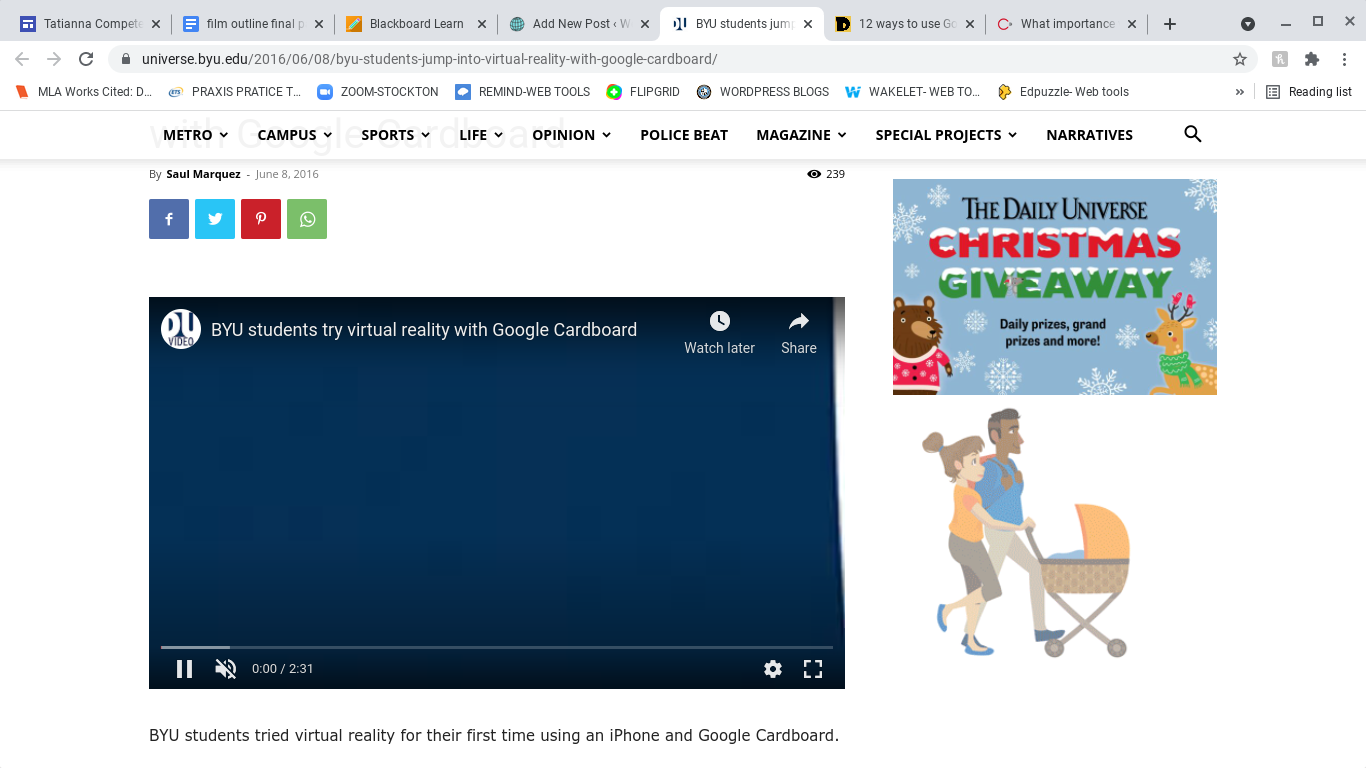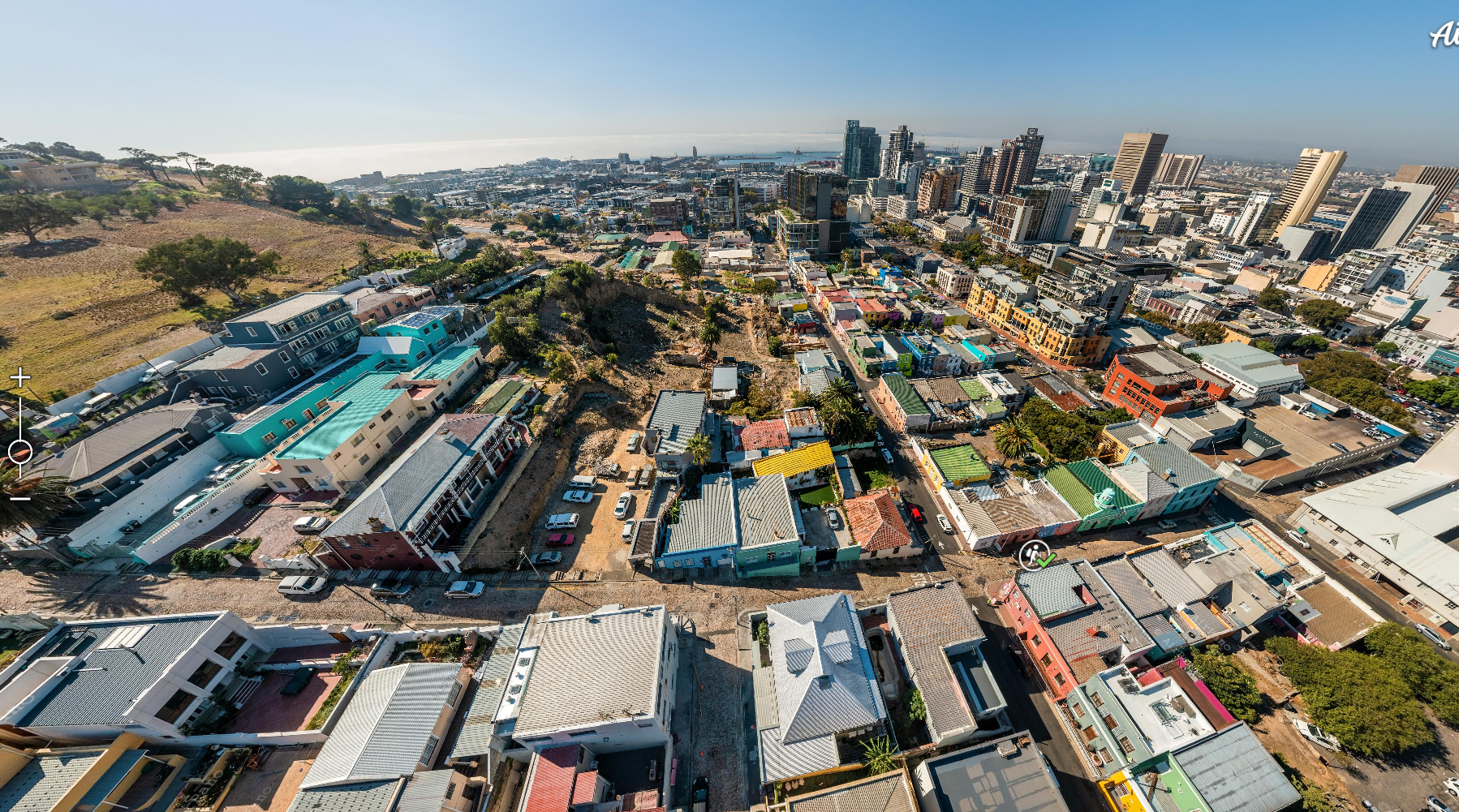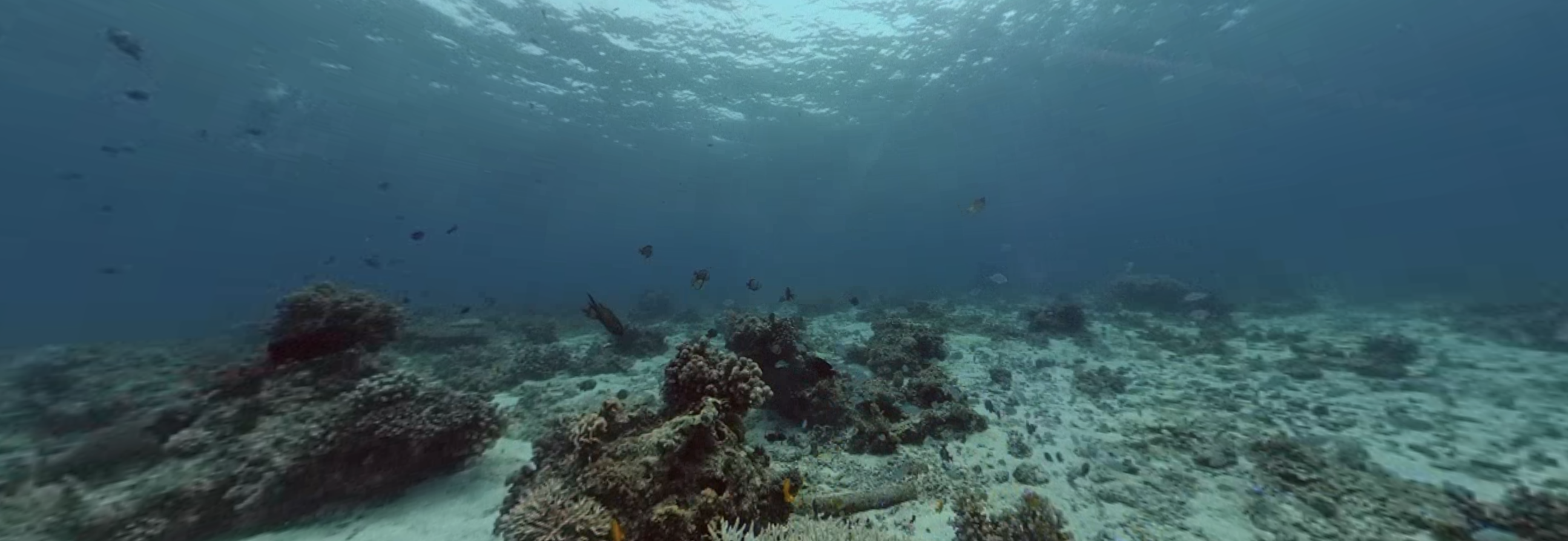Home » Posts tagged '#virtualfieldtrip'
Tag Archives: #virtualfieldtrip
Google Cardboard- #10
By, Tatianna Competello
For our blog post this week we had the choice of picking a learning tool that can be used for virtual reality in classrooms. The tool I decided to talk about is called Google Cardboard. You may be wondering what this app is and how it works. This is an app where you can try virtual reality right from your phone, using Google Cardboard. This virtual reality headset is built from basic cardboard or plastic that brings the viewer in a video or gives them a 360-degree view of an image. It makes the viewer feel like they are actually in that location when in reality they are in the comfort of their own home or classroom. You can view pictures, play games, and experience virtual reality through a VR viewer that you can buy or make at home. This is a great and fun lesson to teach your students especially if you are teaching virtually. I added a video below explaining what exactly Google Cardboard is and how to use it in class. I think this is an interesting video and explains everything you need to know about this app perfectly. You can click here to watch it.
The first step to using this learning tool is to go to your app store and download the app.
This is a screenshot I took of the video to show you a preview of what it looks like on Youtube.
When it comes to teaching students of any age reality can always be a challenge. One of the biggest problems being you do not face to face with the students and this can be make learning difficult. I think any app that will allow students to learn something new and be creative is the best lesson a teacher can teach. With Google Cardboard students develop creative skills and be in charge of their learning. With this app you can teach students how to use virtual reality technology can be used to engage students in topics related to geography, history, or literature by offering a deeply immersive sense of place and time. For example, you can take the students on a virtual field trip and how the students watch the trip the whole time through the google cardboard they created with their phone. I found a very detailed and interesting link that examples several ways how virtual reality with google cardboard can be used together in a classroom. This link truly shows you so many reasons why you should use this app for teaching and learning. You can click here to find it.
This is a typical example of what google cardboard looks like when made and ready to use.
Now you may be wondering what are some specific ways the teachers and students can use this in the classroom. To start, you can take the students on virtual field trips. With this, students can choose a place they would like to go to, based on the current area they are in during the class time. The students could all go to the same place if they want or different places, that part does not matter. The students can look at this location through their google cardboard and then share with the class what they learned from this lesson as well as what this site looked like through the cardboard.
This picture is an example of what taking a virtual field trip would look like for the students.
Another way the students can use this app in class is by watching 360- degree videos. There are hundreds of videos the students can watch and on almost any topic the students want to watch the videos on. Such as skydiving, sharks swimming or taking the children on a tour of a museum with history made in it. When it comes to teaching a specific lesson in class you can find a video of the topic you are teaching and have the students watch this video in class.
This picture is an example of what a 360-degree video would look like using Google Cardboard.
A very creative way students can use google cardboard in the classroom would be to let the students create their projects or lesson plans. This can help students can a real idea of how to use this app and all the features that come with it. The best part about this assignment is that the students can make their 3-D pictures and then share with the class their picture is and why they chose it. This also helps to improve students’ creativity skills. You can click here to see twelve fun ways the students can use this app in the class with specific details for each assignment.
You can watch this video below with students using Google Cardboard for the first time as well as their reactions. I thought this video fit perfectly for this assignment. You can click here to watch it.

The last part of this discussion is to talk about how google cardboard can contribute to a successful global collaboration. According to the website, it states how “Virtual Reality creates an artificial environment with software. The artificial environment gets presented to the audiences in a way that encourages them to accept and believe it as a real environment. VR technology creates primary experience focusing on two senses, i.e., vision and sound.” One of the best traits that make google cardboard so successful is that students can go on virtual field trips around the world, and be able to see all these places just with their computer at home. The students do not actually have to go to these places physically. When it comes to global collaborations, as a teacher you can have your students interact with other students around the world by going on skype or zoom, and the students could even work on similar assignments together. A great assignment would be to create a google classroom and then have the students come up with a lesson plan on how to use and create google cardboard and then show other students around the world how to use this, and share that experience together.
Virtual Field Trip: The Louvre
With The Louvre’s virtual tours page, anyone can admire the beautiful galleries from the comfort of their own home, completely free.

The site allows you to travel through the museum and even click on the art for a better look and to read the plaque for each exhibit as if you’re truly there (with much less of a crowd). The website offers multiple virtual tours such as The Advent of the Artist which features works by Delacroix, Rembrandt, Tintoret, and more. My personal favorite virtual tour is titled Founding Myths: From Hercules to Darth Vader. This exhibit, with vibrant colored walls and even more stunning art, depicts how various artists around the world have created works inspired by myths.
The Louvre website also offers virtual activities for adults and children. There are podcasts, events, and historic cartoon videos for children.
Below is a video posted by the Musée explaining the history behind the building.
Thank you for reading.
Samantha Pollina
Roma: La città di magico eternità
![[Image description: Rome's Trevi Fountain.] Via Unsplash.](https://blogs.stockton.edu/webtools/files/2021/11/photo-1525874684015-58379d421a52.jpeg)
Is there a city in the world more iconic than Rome, Italy? Society was practically built on Rome, which housed an empire that influenced the Western World for centuries to come. For my virtual tour, choosing Italy was a no-brainer, but I didn’t feel like a tourist for immediately leaning toward this iconic tourist city.
I am not going to focus on the Colosseum, because that’s just too touristy. So I started on Capitoline Hill, which was one of Rome’s original 7 hills. It was here that Rome’s first mint was created in The Temple of Juno Moneta (today’s Church of Santa Maria in Aracoeli). The hill became the seat of the city’s government in the year 1,000, which was also where the Senate Building and the Tabularium (Rome’s archives) stood.
Another iconic image in the Eternal City is the Spanish Steps, located in Piazza di Spagna. Thanks to its Baroque architecture that hosts the famous Barcaccia Fountain, tourists throng here every year (except for during COVID in 2020, of course).
The steps go to the Trinita Church, another Baroque marvel commissioned by Pope Innocent XII who had Francesco De Sanctis build it in the 18th century.

Perhaps nothing is more formidable than the Castel Sant’Angelo, the towering papel fortress that towers in the elegant neighborhood of Prati. This mighty structure is the guardian of the Tiber River, towering over its flowing waters for thousands of years. In 123 AD, Emperor Hadrian built the fortress as a tomb for himself and his family, and throughout the ages, it was used as an imperial mausoleum for Roman emperors until the Middle Ages when it became a fortress to protect the city. Despite this iconic stone structure’s many uses, it’s fair to say that no matter what time period it was, it symbolizes Rome’s imperial power and solidifies the city’s place as an iconic world heritage site.
The best part about taking a virtual field trip in such an iconic city is being able to learn about the history behind such imposing monuments. The Capitoline Hill was where such important politics occured throughout the empire’s history, and Castel Sant’Angelo’s 2,000+ existence over the Tiber River is a perfect symbol of the city’s significance.
Rome’s history spans centuries, but what makes it unique is its fascinating combination of ancient paganism and Old World Catholicism everywhere you look. The very cobblestones lining the piazze breathe history, whether it be ancient or from the modern era. It isn’t called the Eternal City for nothing.
Air Pano’s Tour of Cape Town

Our world is filled with so many different wonders, and there’s nothing quite like visiting a new place. Virtual field trips are the closest thing we can get to actual trips, and for those who might not have the time or resources for actual trips, this is a wonderful assimilating experience. These virtual field trips provide you quite literally with an overview of a location of your choosing. I toured the southern-most country of Africa, South Africa. More specifically I saw the coastal gem of South Africa, Cape Town. Cape Town is located as south as you can get in South Africa and is known globally for it’s surf and surf culture. What most don’t know, or see, was shown by Air Pano’s virtual tour.
Air Pano showed Cape Town in a brand new light. The famous sunsets and beaches are the highlighted experiences at first, of course, because that’s what expected of Cape Town. Table Mountain and Lion’s Head, two geographic formations Cape Town is known for and built between, became much larger in the visuals provided. The town seemed to be built in a valley the way the mountains rose above.

I can’t explain the beauty better than a picture can. Usually cities don’t get credited as beautiful places, but the geography surrounding the city creates an encapsulation highlighting the beauty within the city walls. The city park, the memorials and statues, and even the homes of Cape Town. The impoverished sections within the city don’t pose much promise, but from the sky the housings’ colors pop out like murals on a barren wall. The painted tile roofs vary from red to blue, and very color in between.

I was truly stunned by this virtual tour from Air Pano. After I viewed Cape Town’s virtual tour I viewed Cascais, Portugal and a Russian island that I had need heard of. Beauty spans every inch of this world, it’s all about how it’s displayed.
Come with me on a Virtual Field Trip!
This week I took a virtual field trip to the Coral Reef in Panglao, Philippines.
I chose to go on this trip because I love the ocean and admire all of its beauty. On this trip, I was able to look at all the different kinds of fish around me. I could zoom in to catch a closer look. I could also look up to see the sun shining down on the ocean water. When I looked down I could see the reef beneath my feet.

There were a bunch of different view options for the video. This helped me see the Reef in so many different ways. I was truly amazed at how clear the videos were.

Virtual field trips are an amazing way to show students in the classroom different places all over the world. This will keep them engaged and excited in class when they see the variety of places they can go!
Thank you for reading!
Jillian DeMore
@DeMoreJillian
Recent Comments